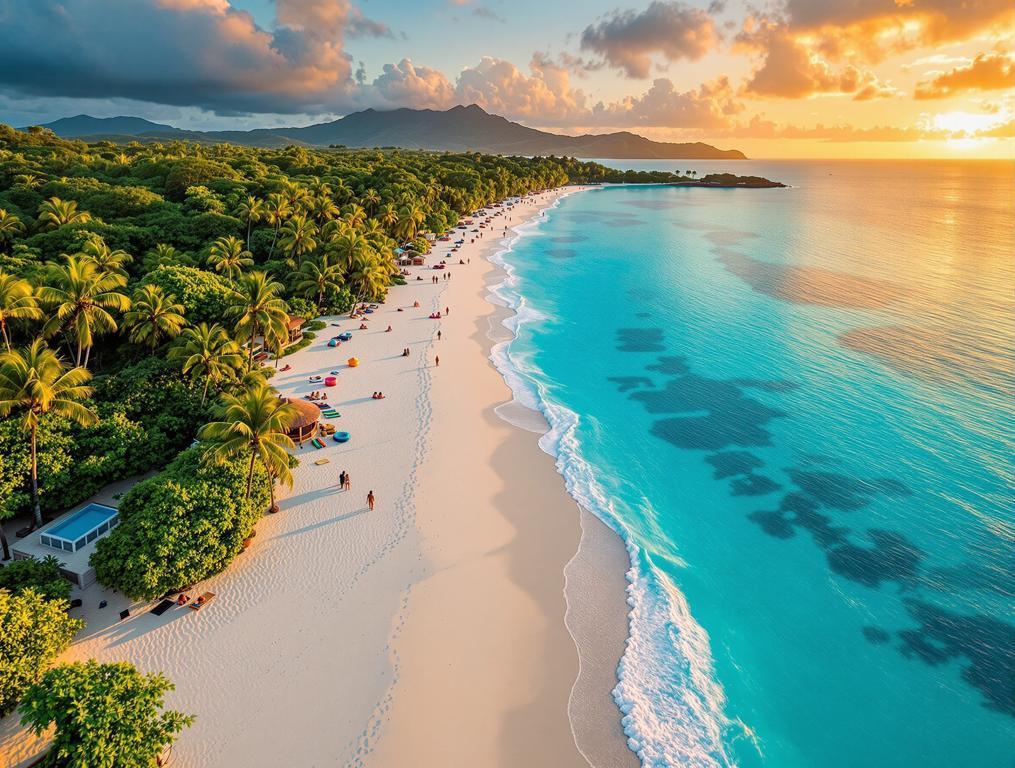The sun burns orange-gold over the East China Sea as I step onto the pristine white sand of Sunset Beach. It’s my first evening on Ishigaki Island, where just 49,000 residents share this tropical paradise with visitors seeking alternatives to overcrowded Okinawan beaches. Unlike Naha’s packed shorelines, here I count barely two dozen people scattered across 300 meters of shoreline. A gentle breeze carries notes of salt and plumeria as the late June day cools.
Beyond the crystalline waters, I notice something unusual – a series of safety nets creating a protected swimming area. A small handwritten sign in Japanese and English explains their purpose. This is my first hint that Sunset Beach harbors secrets most tourists to Japan never discover.
Japan’s Hidden Alternative to Okinawa’s Tourist Crowds
While millions of visitors flood Okinawa’s main island each year, Ishigaki remains blissfully uncrowded. The beach’s gentle slope creates a shallow swimming area perfect for families, while safety nets offer protection from seasonal jellyfish – a thoughtful touch rarely seen at Japan’s more famous beaches.
“We cherish our quiet beaches. Even during Golden Week, you won’t find the crowds here that you see in Naha. We like to keep it this way,” a vendor tells me as he arranges rental equipment near the shore.
Unlike the commercialized beaches of Naha, Sunset Beach maintains its untouched character. No towering hotels crowd the shoreline – just a small rental shop and a rustic beachside café serving fresh mango smoothies for ¥500. The lack of development is intentional, preserving both the natural environment and local lifestyle.
Tomorrow I’ll explore beyond the nets, where vibrant coral reefs teem with marine life. Local guides offer snorkeling tours to spots where 85 species of tropical fish dart among the corals. Unlike the degraded reefs of more frequented destinations, Ishigaki’s underwater ecosystems remain remarkably intact.
Hawaii’s Japanese Cousin Without the Crowds
The striking blue waters and white sand bear an uncanny resemblance to Hawaii’s North Shore beaches, but with a distinctly Japanese cultural backdrop. Local families gather for sunset picnics, spreading tarps rather than beach towels – a quintessentially Japanese adaptation to beach life.
“I’ve been to Hawaii three times, but I prefer it here. Same beautiful water but half the people and twice the cultural experience. Plus, I can actually afford the beachfront accommodations.”
The comparison is apt – both destinations offer spectacular marine environments, but Ishigaki delivers this without the massive tourism infrastructure that has transformed Hawaii. Here, restaurants serve fresh catch prepared with black sugar – Ishigaki’s specialty crop – alongside traditional Okinawan dishes like goya champuru.
Unlike Nicaragua’s dramatic tidal beaches, Sunset Beach maintains consistent shorelines protected by its safety nets. What it lacks in dramatic tides, it compensates with accessibility and convenience for families seeking reliable swimming conditions.
The island’s position as part of the Yaeyama archipelago, Japan’s southernmost inhabited islands, gives it a subtropical climate more akin to Taiwan than Tokyo. This creates a unique fusion of Japanese efficiency with a laid-back island rhythm that feels distinctly un-Japanese.
What the Guidebooks Won’t Tell You
Visit between April and late June to avoid both typhoon season and summer crowds. July brings increased rainfall and the risk of storms disrupting ferry service to nearby islands. When I asked locals about the best time, they unanimously recommended early June for ideal weather and minimal crowds.
While most visitors stick to the netted areas, adventurous snorkelers should head to the southern end of the beach at low tide to discover hidden tide pools teeming with marine life. Just be sure to bring water shoes to protect against sharp coral fragments.
For the best cultural experience, time your visit to coincide with the Yaeyama Matsuri festival in early July, when traditional music and dance performances bring the island’s heritage to life. Local craftspeople sell handmade textiles using patterns unique to the Yaeyama Islands.
As darkness falls over Sunset Beach, I watch local families pack up their picnics. My photographer wife Sarah would love capturing this scene – the silhouettes of children against the fading light, the fishermen casting final lines near the shore. Like the Okinawan concept of “nankurunaisa” (everything will work out in time), this beach reveals itself gradually to those patient enough to discover its rhythms. Tomorrow I’ll return at dawn when the beach belongs only to early risers and the sea turtles that occasionally nest along its shores.
